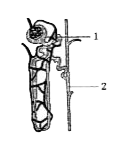Explain the steps in the formation of an ovum from an oogonium in humans.
or " "
Suggest and explain any three Assited Reproductive Technologies (ART) to an infertile couple.
Step-by-Step Solution for the Formation of an Ovum from an Oogonium in Humans
1. Oogenesis Overview: Oogenesis is the process by which an ovum (egg) is formed from an oogonium. This process occurs in the ovaries and involves several stages.
2. Phases of Oogenesis: Oogenesis can be divided into three main phases:
- Multiplication Phase
- Growth Phase
- Maturation Phase
3. Multiplication Phase:
- During the embryonic development of a female, primordial germ cells differentiate into numerous oogonia.
- The oogonia undergo repeated mitotic divisions, increasing their number significantly.
4. Growth Phase:
- Some oogonia grow larger and develop into primary oocytes.
- This transition marks the onset of meiosis I, where the primary oocyte begins the process of cell division but halts at prophase I until puberty.
5. Maturation Phase:
- Upon reaching puberty, the primary oocyte completes meiosis I, resulting in two haploid cells: a secondary oocyte and a first polar body.
- The secondary oocyte is the cell that will be ovulated, while the polar body typically degenerates.
6. Completion of Meiosis:
- The secondary oocyte undergoes meiosis II but only completes this division if fertilization occurs.
- Upon fertilization, the secondary oocyte divides to form a mature ovum and a second polar body.
- The first polar body may also divide to produce two additional polar bodies.
7. Final Outcome:
- The end result of oogenesis is one mature ovum and up to three polar bodies, which are non-functional and eventually degenerate.
- Multiplication Phase
- Growth Phase
- Maturation Phase
- During the embryonic development of a female, primordial germ cells differentiate into numerous oogonia.
- The oogonia undergo repeated mitotic divisions, increasing their number significantly.
- Some oogonia grow larger and develop into primary oocytes.
- This transition marks the onset of meiosis I, where the primary oocyte begins the process of cell division but halts at prophase I until puberty.
- Upon reaching puberty, the primary oocyte completes meiosis I, resulting in two haploid cells: a secondary oocyte and a first polar body.
- The secondary oocyte is the cell that will be ovulated, while the polar body typically degenerates.
- The secondary oocyte undergoes meiosis II but only completes this division if fertilization occurs.
- Upon fertilization, the secondary oocyte divides to form a mature ovum and a second polar body.
- The first polar body may also divide to produce two additional polar bodies.
- The end result of oogenesis is one mature ovum and up to three polar bodies, which are non-functional and eventually degenerate.
Similar Questions
Suggest and explain any three Assisted Reproductive Technologies (ART) to an infertile couple.
View SolutionName three assisted reproductive technologies that help infertile couples to have children
View SolutionMention the primary aim of the 'Assisted Reproductive Technology'' (ART) programme. Briefly explain IVF, GIFT and ZIFT
View SolutionWhat are the assisted reproductive techniques practised to help infertile couples? Describe any three techniques
View SolutionThe horrors of the two World Wars, led to the formation of the United Nations Organization, while the formation of the Non-Aligned Movement followed later. In this context, answer the following:
Explain any three functions of the Security Council.
View SolutionAssertion : Infertility is the inability to produce children inspite of unprotected sexual co-habitation
Reason : Infertile couples could have children using assisted reproductive technologies (ART)
View SolutionExplain the development of a secondary oocyte ( ovum) in a human female from the embryonic stage upto its ovulation. Name the hormones involved in this process.
View SolutionThe diagram given below is that of a structure present in a human kidney. Study the same and answer the questions that follows :

(i) Name the structure represented in the diagram.
(ii) What is the liquid entering part T called? Name two substances present in this liquid that are reabsorbed in the tubule.
(iii) What is the fluid that comes to part '2' called? Name the main nitrogenous waste in it.
(iv) Mention the three main steps involved in the formation of the fluid mentioned in (iii) above.
(v) Name the substance which may be present in the fluid part '11 if a person suffer from diabetes mellitus.
View Solution(a) Where does fertilization occur in humans ? Explain the events that occur during this process.
(b) A couple where both husband and wife are producing functional gametes, but the wife is still unable to conceive, is seeking medical aid. Describe any one method that you can suggest to this couple to become happy parents.
View SolutionThe Partition of Bengal and the Formation of the Muslim League were two important events that had its impact on the National Struggle for Independence. In this context, explain the following:
Any three factors leading to the formation of the Muslim League.
View Solution
